Running an ecommerce brand means that merchants essentially have two core doctrines on which they can base their digital marketing strategies: push or pull.
Understanding that, there are two questions that immediately arise:
- What is the difference between push and pull ecommerce marketing?
- Which one is best for brands to utilize?
As the world continues to lean into digital retail as physical retail stores close in droves, it is more important than ever for merchants to intimately understand ecommerce marketing strategies and the nuances between different tactics.
In this piece, we aim to answer the two aforementioned questions comprehensively, thus providing retailers with the knowledge necessary to put these practices to use in the most fruitful way possible.
With that said, let’s go ahead and explore the differences between push and pull in ecommerce marketing.
Ecommerce Marketing: The Difference Between Push and Pull
Push and pull marketing, otherwise referred to as inbound and outbound marketing, are two very different forms of ecommerce marketing. However, each serves a specific purpose.
Push Marketing Explained
In push marketing, the objective is to bring (or push) the brand and its products to relevant audiences. This form of marketing is much more deliberate and gung ho than other inbound marketing methods.
Because push marketing is more aggressive than its counterpart, it is generally preferred by brands that are operating under certain time constraints, attempting to generate sales quickly, or those who are trying to raise awareness about the company and its offerings.
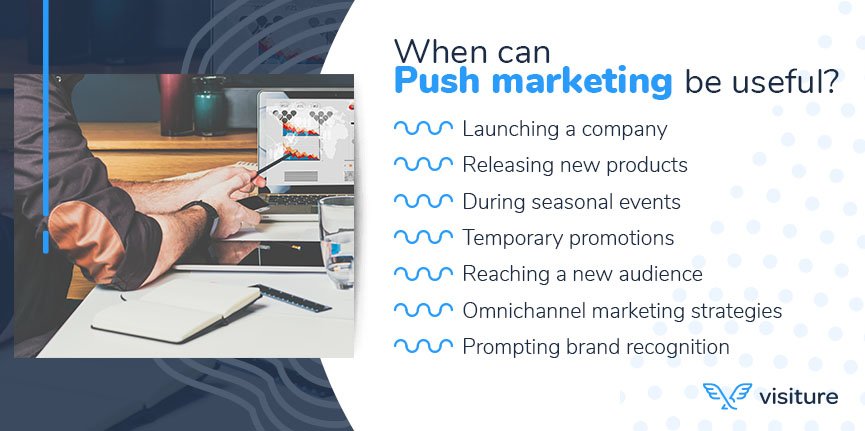
Push marketing can be extremely useful in a variety of circumstances, including:
- Launching a new company or website without an existing following
- When releasing new products
- During seasonal events
- Pushing temporary promotional campaigns, such as sales
- When attempting to reach a new audience
- When supporting omnichannel ecommerce marketing strategies
- Prompting brand recognition
Push marketing is typically a sort of shotgun approach to ecommerce marketing that helps to make a brand and its products more visible, thus producing a quick burst of sales. However, this form of marketing almost always comes at a cost as push campaigns usually involve spending money.
One of the most prominent forms of push marketing is PPC advertising, a marketing tactic wherein retailers run search ads, banner ads, Shopping ads, and other promotional campaigns across various platforms like search engines. As is the model with nearly all of these types of campaigns, sellers will pay a small amount for each click the ad generates.
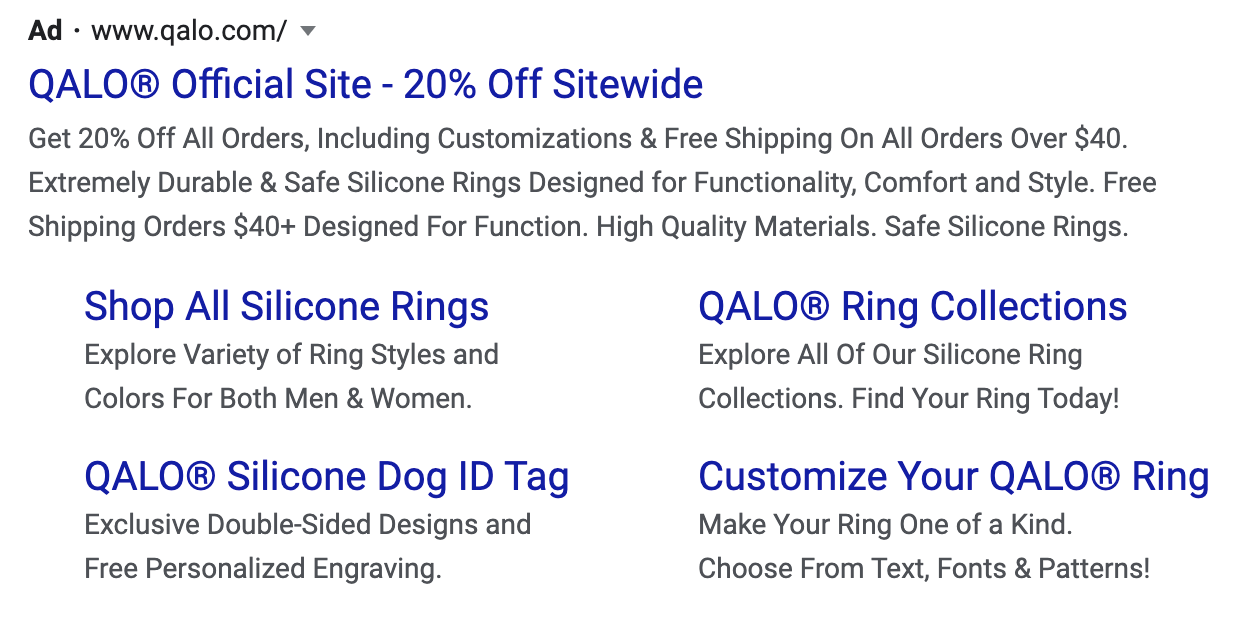
Other forms of push marketing include paid social media marketing strategies that are similar to PPC ads when merchants might pay per thousand impressions.
Pull Marketing Defined
On the other hand, pull marketing involves generating naturally accruing traffic. In other words, sellers develop resources and let customers come to them.
In pull marketing, merchants are aware of the fact that there are already consumers who are actively seeking out the types of products, services, or information that the brand offers. The seller’s job is to make these resources easier for the user to find, thus achieving their end goal.
The most notable forms of pull marketing include search engine optimization (SEO), social media content, customer reviews, and content marketing strategies.
While social media is arguably the most popular of all these methods due to its accessibility, SEO has a long track record for being the most profitable and abiding by the pull methodologies.
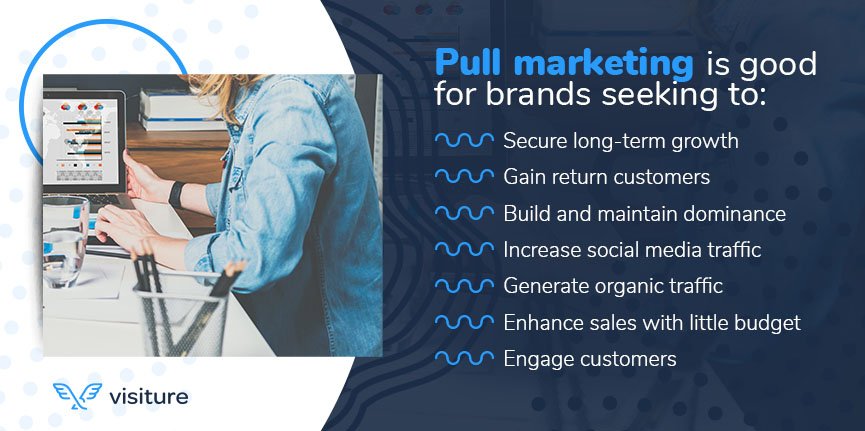
Pull marketing is often employed by ecommerce brands seeking to:
- Secure long-term business growth
- Create a base of return customers and enhance loyalty
- Build and maintain dominance within an industry or niche
- Increase social media traffic and sharing
- Generate organic traffic as a result of visibility
- Enhance sales without a significant marketing budget
- Engage customers at the top of the sales funnel
Juxtaposing Push and Pull
In terms of performance, it is easy to stack the strategies against one another.
For instance, when examining push versus pull marketing statistics, 71 percent of consumers prefer pull marketing techniques like online search, product recommendations, and reviews, and similar tactics.
At the same time, content marketing statistics show that 72 percent of marketers claim that content marketing increases engagement and lead generation. Tack onto these stats the ever-increasing number of social media users and marketing options provided by such platforms, and it becomes quite clear that pull marketing strategies are a vital necessity for business growth in today’s digital era.
However, this is not a lopsided conversation as push strategies can be quite useful as well. In fact, a cursory glance at PPC statistics reveals that:
“50 percent of people arriving at a retailer’s site from paid ads are more likely to buy than those who came from an organic link… 89 percent of the traffic generated by Google Ads is not replaced by organic clicks when ads are paused… 74 percent of brands say PPC is a huge driver for their business.”
The truth of the matter is that brands are most likely to produce the best results by focusing on an omnichannel ecommerce marketing strategy that incorporates elements of both push and pull.
Plainly put, the categories of push and pull are simply too broad and too important for sellers to just focus on one part of the marketing equation.
That said, there is a time and place for each of these tactics, and the results they can yield in different scenarios can be dramatically different.
Ecommerce Marketing: When to Push and When to Pull
Deciding where and when to use push or pull ecommerce marketing strategies will often come down to a brand’s overall business goals.
Prior to selecting which strategies to deploy, conduct some ecommerce market research and ask:
- What does the company seek to achieve?
- Is there a demand?
- What is the product being sold?
- Is the unique selling proposition compelling?
The reality is that push marketing is not suited for every situation, just as pull marketing is not a universal solution. Instead, it is about striking the right balance between the two to ensure that a brand is not overly obnoxious with its push efforts, but also not allowing the competition to grab all the attention.
Much of achieving that harmony comes from knowing a brand’s product, target audience, and the best way to appeal to their needs.
Therefore, push marketing is a fantastic promotional tool if:
- The company is extremely niche
- A startup looking to gain awareness and exposure
For instance, if a retailer sells shoes made from sustainably sourced materials, the brand is likely to be relatively niche, appealing to environmentalists and others with a general interest in that type of footwear.
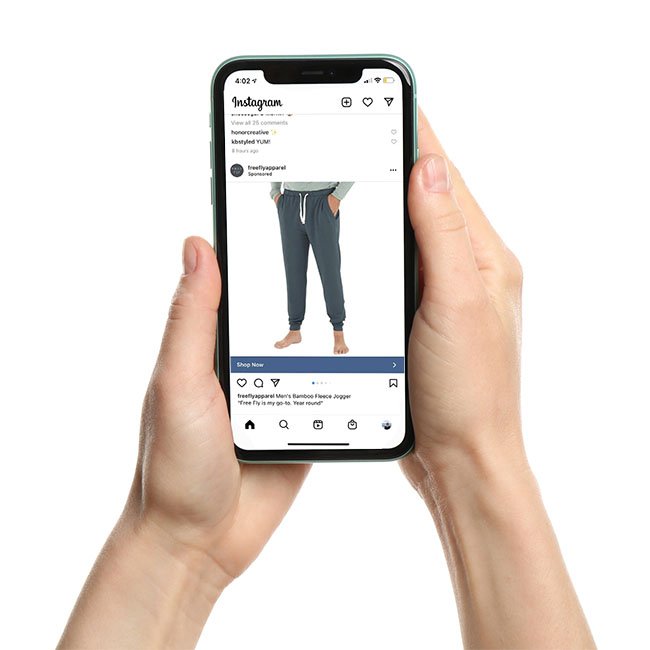
As a result of this dynamic, few are likely to know about the existence of the brand. This means that push marketing can potentially go a long way in generating sales for the business.
In this case, push marketing will serve to ensure that the business can bring awareness to its products and get its feet off the ground.
On the other hand, pull marketing can be utilized in situations where:
- Customers are seeking something specific and know what they want
- The business aims to cultivate authority within a niche
- The brand offers a truly unique product
Through this strategy, merchants are aiming to entice potential customers and appeal to their qualified interest in the company’s product. When using pull marketing, sellers have a stronger ability to place themselves in the customers’ shoes to understand for what specifically they are searching.
Ecommerce Marketing: Using Push and Pull Together
Those who have read up to this point might get the idea that push and pull marketing are mutually exclusive ideas. However, nothing could be further from the truth.
In reality, businesses can employ push and pull ecommerce marketing strategies to complement one another, thereby producing more outstanding results for each type of campaign.
For instance, SEO is a prime pull strategy, while PPC is a top contender in the push marketing category. While each can be effective in generating the desired results, the reality of the situation is that integrating PPC and SEO together can result in a higher ROI overall.
When combining the push and pull of SEO and PPC, retailers are capable of gaining a wealth of information that can elevate both campaigns to a higher plane of effectiveness. For example, when running PPC campaigns, merchants will inevitably uncover keywords that are effective in getting consumers to convert. Those keywords can then be leveraged in on-site and content optimization efforts, thereby potentially increasing the clicks, traffic and sales generated through SEO campaigns.
Alternatively, by providing PPC advertisers with a company’s SEO data, the team can pinpoint high-performing long-tail keywords to target, pause expensive keywords for which the brand is ranking well organically and implement other strategies to enhance push efforts.
Similarly, if a seller gains a lead through push marketing efforts, they can then turn around and engage that individual with a pull campaign via an email marketing welcome series.
A bit of a side note: While email marketing seems as if it should be a push (outbound) strategy, it is actually a pull (inbound) tactic since the basis of email marketing is founded upon a list of subscribers who willingly gave the business their contact information.
The bottom line here is that while many think of push and pull marketing strategies as separate disciplines, the reality is that they are two sides of the same coin.
Is Push or Pull Marketing More Expensive?
Given that push and pull marketing strategies can often rely on different channels and platforms, their costs will obviously differ.
Generally speaking, push marketing will leverage some form of display advertising, be it search engine ads, social media promos, and the like.
When looking at Google Ads benchmarks, the cost-per-click will vary significantly across industries. However, during the COVID-19 scare, the average cost-per-click across various properties broke down as follows:
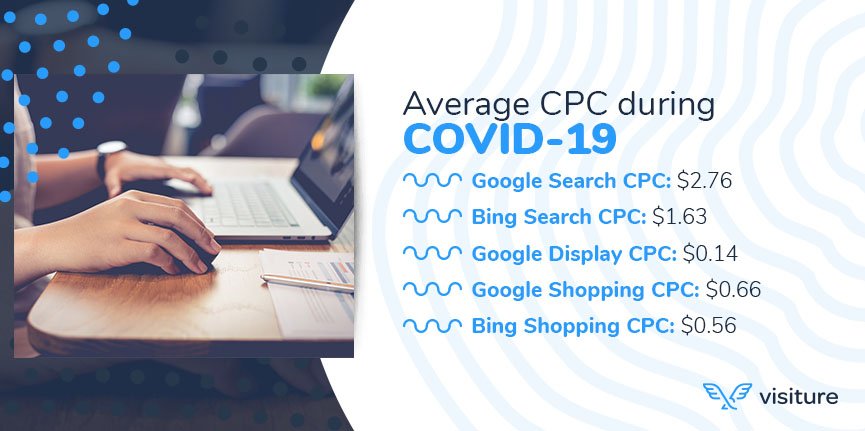
- Average Google Search CPC: $2.76
- Average Bing Search CPC: $1.63
- Average Google Display CPC: $0.14
- Average Google Shopping CPC: $0.66
- Average Bing Shopping CPC: $0.56
Depending on the scope and length of a brand’s PPC ecommerce marketing campaign, pay-per-click ads can vary greatly in their pricing.
As far as SEO is concerned, when asking how much brands should budget for SEO services, Search Engine Journal claims that:
“If you are hiring a top-level SEO company to execute a local campaign, expect to pay $500+ per month. A national or international campaign will require a minimum budget of $2,500 to $5,000 a month.”
However, where SEO holds the financial edge over PPC campaigns is that if merchants do not have the resources to invest in a professional agency (and do possess the know-how), they can technically run their own SEO campaigns for free.
Furthermore, it is essential to keep in mind that PPC campaigns only produce results while they are live. This means that the moment a merchant stops investing in such adverts, the sales come to a screeching halt.
On the other hand, SEO can provide long-term visibility and profitability without continual financial investment. However, the drawback is that SEO takes time to produce results. This means that sellers will have to be patient with their search optimization strategies to pay dividends.
At the end of the day, the push marketing modality is likely to be the more expensive out of the two. That said, it is essential to remember that these two strategies serve radically different purposes and are not mutually exclusive, meaning that they can and do go hand-in-hand when utilized correctly.
Push or Pull: Which Is More Effective?
When answering the question of which ecommerce marketing strategy is more effective, it is important to understand that there are positives and negatives to both tactics (as with most everything in life).
As was just seen, push marketing tends to be more expensive, despite being a fantastic tool for reaching new audiences. Meanwhile, pull marketing truly works best when a company already has something of a loyal following and reputation.
On the other hand, many pull marketing strategies take time to produce results. This means that businesses will end up investing substantial amounts of time, energy, and resources into inbound ecommerce marketing strategies without seeing tangible results for a fair bit of time.
In terms of effectiveness, push and pull ecommerce marketing strategies are both equally sufficient in completing their purpose. However, when looked at on a timeline, push marketing is truly only competent in the short-term, while pull marketing is geared toward the long game.
Once again, the conclusion to be drawn from this is that push and pull marketing are complementary strategies that work synergistically. While one aims to cultivate awareness and sales in the now, the other aims to bring long-term prosperity and reputability to a brand.
Therefore, asking which is more effective is an incomplete question. Instead, what sellers should really be asking is: Which strategy is more effective for a given situation, and how can its counterpart be utilized to bolster efforts and produce a better outcome?
Final Thoughts
Like any other ecommerce marketing strategy or initiative, push and pull marketing tactics require planning and consideration of the target audience, marketplace, and circumstances at hand.
No matter which a merchant opts to leverage for a particular scenario, what does not change is that each campaign type should be closely monitored, reviewed, and optimized on a continual basis.
If your company is interested in optimizing its push and pull dynamic for maximum profitability, reach out to Wpromote today and see how we can successfully accomplish your goals.
Explore Wpromote’s approach to digital transformation with our full guide to The Challenger Framework: A Radical Reimagining of Performance Marketing.






Responses